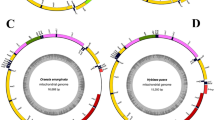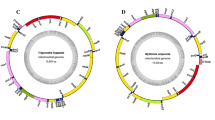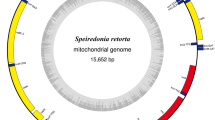Abstract
In this study, the complete mitogenomes of Sympis rufibasis, Lacera noctilio, Oxyodes scrobiculata, Mocis undata, and Artena dotata were newly sequenced to bring up-to-date the database using the next-generation sequencing methods. The gene order of all sequenced mitogenomes was identical consisting of 13 protein-coding genes (PCGs), 22 transfer RNA genes (tRNAs), two ribosomal RNA genes (rRNAs), and a non-coding A+T-rich region, which were common to other Lepidopteran insects. All protein-coding genes (PCGs) initiated with a canonical ATN codon and ended with TAN or an incomplete stop codon, single T. The A+T-rich region of S. rufibasis, L. noctilio, O. scrobiculata, M. undata, and A. dotata are 406 bp, 462 bp, 372 bp, 410 bp, and 406 bp long, respectively, containing number of characteristics that are distinctive to Noctuoidea moths. We analyzed concatenated amino acid sequences of protein-coding genes not including rRNAs, using Maximum Likelihood and Bayesian Inference methods. The phylogenetic analyses indicated that the tribe relationships within Erebinae were reconstructed as (Sypnini+((Erebini 1+Poaphilini 1)+((Euclidiini+Catocalini+(Hypopyrini+Erebini 2))+((Hulodini+(Poaphilini 2+Ophiusini))))). Phylogenetic analyses supported and confirmed the monophyly of the subfamilies’ relationships as follows: (Hypeninae+Lymantriinae)+((Scoliopterginae+((Calpinae+Erebinae)+((Herminiinae+Aganainae)+Arctiinae)))) within Erebidae.








Similar content being viewed by others
Data Availability
The datasets generated during and/or analyzed during the current study are available in the [NCBI-National Center for Biotechnology Information] repository, https://www.ncbi.nlm.nih.gov. The dataset for all the 5 species has been submitted to NCBI and released and is publicly available at https://www.ncbi.nlm.nih.gov/nuccore/MW846302; https://www.ncbi.nlm.nih.gov/nuccore/MW846301; https://www.ncbi.nlm.nih.gov/nuccore/MW865753; https://www.nlm.nih.gov/nuccore/MW802208; https://www.ncbi.nlm.nih.gov/nuccore/MW697902.
References
Anderson S, Bankier AT, Barrell BG, De Bruijn MHL, Coulson AR, Drouin J et al (1981) Sequence and organization of the human mitochondrial genome. Nature 290(5806):457–465. https://doi.org/10.1038/290457a0
Bernt M, Donath A, Jühling F et al (2013) MITOS: improved de novo metazoan mitochondrial genome annotation. Mol Phylogenet Evol 69:313–319
Boore JL (1999) Animal mitochondrial genomes. Nucleic Acids Res 27(8):1767–1780. https://doi.org/10.1093/nar/27.8.1767
Cameron SL (2014) Insect mitochondrial genomics: implications for evolution and phylogeny. Annu Rev Entomol 59(1):95–117. https://doi.org/10.1146/annurev-ento-011613-162007
Cameron SL, Whiting MF (2008) The complete mitochondrial genome of the tobacco hornworm, Manduca sexta (Insecta: Lepidoptera: Sphingidae), and an examination of mitochondrial gene variability within butterflies and moths. Gene 408(1–2):112–123. https://doi.org/10.1016/j.gene.2007.10.023
Cao SS, Du YZ (2014) Characterization of the complete mitochondrial genome of Chilo auricilius and comparison with three other rice stem borers. Gene 548(2):270–276. https://doi.org/10.1016/j.gene.2014.07.045
Cao Y, Hao JS, Sun XY, Zheng B, Yang Q (2016) Molecular phylogenetic and dating analysis of pierid butterfly species using complete mitochondrial genomes. Genet Mol Res. 15(4): gmr15049196. https://doi.org/10.4238/gmr15049196
Chai HN, Du YZ (2012) The complete mitochondrial genome of the pink stem borer Sesamia inferens in comparison with four other Noctuid moths. Int J Mol Sci 13(8):10236–10256. https://doi.org/10.3390/ijms130810236
Chen Q, Chen L, Liao CQ, Wang X, Wang M, Huang GH (2022) Comparative mitochondrial genome analysis and phylogenetic relationship among lepidopteran species. Gene 830:146516. https://doi.org/10.1016/j.gene.2022.146516
Cheng XF, Zhang LP, Yu DN, Storey KB, Zhang JY (2016) The complete mitochondrial genomes of four cockroaches (Insecta: Blattodea) and phylogenetic analyses within cockroaches. Gene 586(1):115–122. https://doi.org/10.1016/j.gene.2016.03.057
Dai LS, Zhu BJ, Zhao Y, Zhang CF, Liu CL (2016) Comparative mitochondrial genome analysis of Eligma narcissus and other lepidopteran insects reveals conserved mitochondrial genome organization and phylogenetic relationships. Sci Rep 6:26387. https://doi.org/10.1038/srep26387
Dierckxsens N, Mardulyn P, Smits G (2017) NOVOPlasty: denovo assembly of organelle genomes from whole-genome data. Nucleic Acids Res 45(4):e18
Djoumad A, Nisole A, Zahiri R, Freschi L, Picq S, Gundersen-Rindal DE et al (2017) Comparative analysis of mitochondrial genomes of geographic variants of the gypsy moth, Lymantria dispar reveals a previously undescribed genotypic entity. Sci Rep 7(1):14245. https://doi.org/10.1038/s41598-017-14530-6
Fei Y, Yanru S, Lianxi X, Haili Y, You P (2013) The complete mitochondrial genome of Paracymoriza prodigalis (Leech, 1889) (Lepidoptera), with a preliminary phylogenetic analysis of Pyraloidea. Aquat Insects Int J Freshw Entomol 35(3–4):71–88. https://doi.org/10.1080/01650424.2014.948456
Fibiger M, Lafontaine JD (2005) A review of the higher classification of the Noctuoidea (Lepidoptera) with special reference to the Holarctic fauna. Esperiana 11:7–92
Garey JR, Wolstenholme DR (1989) Platyhelminth mitochondrial DNA: evidence for early evolutionary origin of a tRNAser AGN that contains a dihydrouridine arm replacement loop, and of serine-specifying AGA and AGG codons. J Mol Evol 28(5):374–387. https://doi.org/10.1007/BF02603072
Gong YJ, Wu QL, Wei SJ (2013) Complete mitogenome of the Argyrogramma agnata (Lepidoptera: Noctuidae). Mitochondrial DNA 24(4):391–393
Gong N, Yang L, Chen XS (2021) Comparative analysis of twelve mitogenomes of Caliscelidae (Hemiptera: Fulgoromorpha) and their phylogenetic implications. PeerJ 9:e12465. https://doi.org/10.7717/peerj.12465
Greiner S, Lehwark P, Bock R (2019) Expanded toolkit for the graphical visualization of organellar genomes. research version 1.3.1. Organellar genome DRAW (OGDRAW). Expanded toolkit for the graphical visualization of organellar genomes. Nucleic Acids Res 47(1):59–64
Hao JJ, Hao JS, Sun XY, Zhang LL, Yang Q (2014) The complete mitochondrial genomes of the Fenton’s wood white, Leptidea morsei, and the lemon emigrant, Catopsilia pomona. J Insect Sci 14(130):130. https://doi.org/10.1093/jis/14.1.130
Huang Y, Liu Y, Zhu XY, Xin ZZ, Zhang HB, Zhang DZ et al (2019) Comparative mitochondrial genome analysis of Grammodes geometrica and other noctuid insects reveals conserved mitochondrial genome organization and phylogeny. Int J Biol Macromol 125:1257–1265. https://doi.org/10.1016/j.ijbiomac.2018.09.104
Katoh K, Toh H (2010) Parallelization of the MAFFT multiple sequence alignment program. Bioinformatics 26(15):1899–1900. https://doi.org/10.1093/bioinformatics/btq224
Kumar S, Stecher G, Li M et al (2018) MEGA X: Molecular Evolutionary Genetics Analysis across Computing Platforms. Mol Biol Evol 35(6):1547–1549
Liu QN, Zhu BJ, Dai LS, Wei GQ, Liu CL (2012) The complete mitochondrial genome of the wild silkworm moth Actias selene. Gene 505(2):291–299. https://doi.org/10.1016/j.gene.2012.06.003
Liu QN, Bian DD, Jiang SH, Ge BM, Zhou CL, Tang BP (2015) Characterization of the complete mitochondrial genome of the Oriental armyworm, Mythimna separata (Lepidoptera: Noctuidae). Eur J Entomol 112(3):399–408. https://doi.org/10.14411/eje.2015.055
Lu HF, Su TJ, Luo AR, Zhu CD, Wu CS (2013) Characterization of the complete mitochondrion genome of diurnal moth Amata emma (Butler) (Lepidoptera: Erebidae) and its phylogenetic implications. PLoS ONE 8(9):e72410. https://doi.org/10.1371/journal.pone.0072410
Ma Y, He K, Yu PP, Yu DN, Cheng XF, Zhang JY (2015) The complete mitochondrial genomes of three bristletails (Insecta: Archaeognatha): the paraphily of Machilide and insights into Archaeognathan phylogeny. PLoS ONE 10(1):e0117669. https://doi.org/10.1371/journal.pone.0117669
Ojala D, Montoya J, Attardi G (1981) tRNA punctuation model of RNA processing in human mitochondria. Nature 290(5806):470–474. https://doi.org/10.1038/290470a0
Perera OP, Walsh TK, Luttrell RG (2016) Complete mitochondrial genome of Helicoverpa zea (Lepidoptera: Noctuidae) and expression profiles of mitochondrial-encoded genes in early and late embryos. J Insect Sci 16(1): 40:1–10. https://doi.org/10.1093/jisesa/iew023
Perna NT, Kocher TD (1995) Patterns of nucleotide composition at fourfold degenerate sites of animal mitochondrial genomes. J Mol Evol 41(3):353–358. https://doi.org/10.1007/BF00186547
Ramírez-Ríos V, Franco-Sierra ND, Alvarez JC, Saldamando-Benjumea CI, Villanueva-Mejía DF (2016) Mitochondrial genome characterization of Tecia solanivora (Lepidoptera: Gelechiidae) and its phylogenetic relationship with other lepidopteran insects. Gene 581(2):107–116. https://doi.org/10.1016/j.gene.2016.01.031
Shadel GS, Clayton DA (1997) Mitochondrial DNA maintenance invertebrates. Annu Rev Biochem 66(1):409–435. https://doi.org/10.1146/annurev.biochem.66.1.409
Sivasankaran K, Mathew P, Anand S, Ceasar SA, Maria Packiam S, Ignacimuthu S (2017) Complete mitochondrial genome sequence of fruit-piercing moth Eudocima phalonia (Linnaeus, 1763) (Lepidoptera: Noctuoidea). Genomic Data 14:66–81. https://doi.org/10.1016/j.gdata.2017.09.004
Sun QQ, Sun XY, Wang XC, Gai YH, Hu J, Zhu CD et al (2012) Complete sequence of the mitochondrial genome of the Japanese buff-tip moth, Phalera flavescens (Lepidoptera: Notodontidae). Genet Mol Res 11(4):4213–4225. https://doi.org/10.4238/2012.September.10.2
Sun CH, Liu HY, Min X, Lu CH (2020a) Mitogenome of the little owl Athene noctua and phylogenetic analysis of Strigidae. Int J Biol Macromol 151:924–931. https://doi.org/10.1016/j.ijbiomac.2020.02.238
Sun Y, Zhu Y, Chen C, Zhu Q, Zhu Q, Zhou Y Zhou. Jun and Zhang, H (2020b) The complete mitochondrial genome of Dysgonia stuposa (Lepidoptera: Erebidae) and phylogenetic relationships within Noctuoidea PeerJ e8780. https://doi.org/10.7717/peerj.8780
Sun Y, Tian S, Qian C, Sun Y, Abbas MN, Kausar S et al (2016a) Characterization of the complete mitochondrial genome of Spilarctia robusta (Lepidoptera: Noctuoidea: Erebidae) and its phylogenetic implications. Eur J Entomol 113:558–570. https://doi.org/10.14411/eje.2016.076
Sun YX, Wang L, Wei GQ, Qian C, Dai LS, Sun Y et al (2016b) Characterization of the Complete mitochondrial Genome of Leucoma salicis (Lepidoptera: Lymantriidae) and Comparison with Other Lepidopteran Insects. Sci Rep 6:39153. https://doi.org/10.1038/srep39153
Sun Y, Huang H, Liu Y, Liu S, Xia J, Zhang K et al (2021) Organization and phylogenetic relationships of the mitochondrial genomes of Speiredonia retorta and other lepidopteran insects. Sci Rep 11(1):2957. https://doi.org/10.1038/s41598-021-82561-1
Taanman JW (1999) The mitochondrial genome: structure, transcription, translation and replication. Biochim Biophys Acta 1410(2):103–123. https://doi.org/10.1016/s0005-2728(98)00161-3
Tillich M, Lehwark P, Pellizzer T et al (2017) GeSeq–versatile and accurate annotation of organelle genomes. Nucleic Acids Res 45(1):W6–W1. https://doi.org/10.1093/nar/gkx391
Timmermans MJTN, Daghmoumi SM, Glass D, Hamilton CA, Kawahara AY, Kitching IJ (2019) Phylogeny of the hawkmoth tribe Ambulycini (Lepidoptera: Sphingidae) Mitogenomes from museum specimens resolve major relationships. Insect Syst Divers 3(6):1–8. https://doi.org/10.1093/isd/ixz025
van Nieukerken EJ, Kaila L, Kitching IJ, Kristensen NP, Lees DC, Minet J et al (2011) Order Lepidoptera Linnaeus, 1758. Zootaxa, Animal Biodiversity: an Outline of Higher-Level Classification and Survey of Taxonomic Richness 3148:212–221
Wang Q, Tang G (2017) Genomic and phylogenetic analysis of the complete mitochondrial DNA sequence of walnut leaf pest, Paleosepharia posticata (Coleoptera: Chrysomeloidea). J Asia Pac Entomol 20(3):840–853. https://doi.org/10.1016/j.aspen.2017.05.010
Wang X, Che ZM, Gu XS, Wang M, Huaqng GH, Zwick A (2018) Phylogenetic relationships among Bombycidae s. I. (Lepidoptera) based on analyses of complete mitochondrial genomes. Syst Entomol 44(3):490–498. https://doi.org/10.1111/syen.12337
Weiqing K, Jinhong Y (2015) The complete mitochondrial genome of Rondotia menciana (Lepidoptera: Bombycidae). J. Insect Sci 15(1):48. https://doi.org/10.1093/jisesa/iev032
Wolstenholme DR (1992) Animal mitochondrial DNA: structure and evolution. Int Rev Cytol 141:173–216. https://doi.org/10.1016/S0074-7696(08)62066-5
Wu QL, Cui WX, Du BZ, Gu Y, Wei SJ (2014) The complete mitogenome of the turnip moth Agrotis segetum (Lepidoptera: Noctuidae). Mitochondrial DNA 25(5):345–347
Xin ZZ, Yu Liu Z, Zhu XY, Wang Y, Zhang HB, Zhang DZ et al (2017) Mitochondrial genomes of two Bombycoidea insects and implications for their phylogeny. Sci Rep 7(1):6544. https://doi.org/10.1038/s41598-017-06930-5
Xin ZZ, Liu Y, Zhang DZ, Wang ZF, Tang BP, Zhang HB et al (2018) Comparative mitochondrial genome analysis of Spilarctia subcarnea and other noctuid insects. Int J Biol Macromol 107(A):121–128. https://doi.org/10.1016/j.ijbiomac.2017.08.153
Yang X, Cameron SL, Lees DC, Xue D, Han H (2015) A mitochondrial genome phylogeny of owlet moths (Lepidoptera: Noctuoidea), and examination of the utility of mitochondrial genomes for lepidopteran phylogenetics. Mol Phylogenet Evol 85:230–237. https://doi.org/10.1016/j.ympev.2015.02.005
Yang M, Song L, Shi Y, Yin Y, Wang Y, Zhang P et al (2019) The complete mitochondrial genome of a medicinal insect, Hydrillodes repugnalis (Lepidoptera: Noctuoidea: Erebidae), and related phylogenetic analysis. Int J Biol Macromol 123:485–493. https://doi.org/10.1016/j.ijbiomac.2018.10.149
Zahiri R, Holloway JD, Kitching IJ, Lafontaine JD, Mutanen M, Wahlberg N (2012) Molecular phylogenetics of Erebidae (Lepidoptera, Noctuoidea). Syst Entomol 37(1):102–124. https://doi.org/10.1111/j.1365-3113.2011.00607.x
Zahiri R, Kitching IJ, Lafontaine JD, Mutanen M, Kaila L, Holloway JD et al (2011) A new molecular phylogeny offers hope for a stable family level classification of the Noctuoidea (Lepidoptera). Zool Scr 40(2):158–173. https://doi.org/10.1111/j.1463-6409.2010.00459.x
Zahiri R, Lafontaine JD, Holloway JD, Kitching IJ, Schmidt BCh, Kaila L et al (2013b) Major lineages of Nolidae (Lepidoptera, Noctuoidea) elucidated by molecular phylogenetics. Cladistics 29(4):337–359. https://doi.org/10.1111/cla.12001
Zahiri R, Lafontaine D, Schmidt C, Holloway JD, Kitching IJ, Mutanen M et al (2013a) Relationships among the basal lineages of Noctuidae (Lepidoptera, Noctuoidea) based on eight gene regions. Zool Scr 42(5):488–507. https://doi.org/10.1111/zsc.12022
Zhang LL, Hao JS, Huang DY, Sun XY, Hao JJ, Peng CM et al (2013) Complete mitochondrial genomes of the bright sunbean Curetis bulis and the small copper Lycaena phlaeas (Lepidoptera: Lycaenidae) and their phylogenetic implications. Genet Mol Res 12(4):4434–4445. https://doi.org/10.4238/2013.October.10.9
Zhang DX, Hewitt GM (1997) Insect mitochondrial control region: a review of its structure, evolution and usefulness in evolutionary studies. Biochem Syst Ecol 25(2):99–120. https://doi.org/10.1016/S0305-1978(96)00042-7
Zhang DX, Szymura JM, Hewitt GM (1995) Evolution and structural conservation of the control region of insect mitochondrial DNA. J Mol Evol 40(4):382–391. https://doi.org/10.1007/BF00164024
Zhu XY, Xin ZZ, Liu Y, Wang Y, Huang Y, Yang ZH et al (2018) The complete mitochondrial genome of Clostera anastomosis (Lepidoptera: Notodontidae) and implication for the phylogenetic relationships of Noctuoidea species. Int J Biol Macromol 118(B):1574–1583. https://doi.org/10.1016/j.ijbiomac.2018.06.188
Funding
This study was funded by the Department of Science and Technology (DST)-Science and Engineering Research Board (SERB) [Grant No. EMR/2017/000566]. The authors are grateful to the Director, Entomology Research Institute, Loyola College, Chennai, India for providing the facilities. The funding agency had no role in study design, data collection and analysis, decision to publish, or preparation of the manuscript.
Author information
Authors and Affiliations
Contributions
RAS: conceived and designed the manuscript. MR: conceived and designed the manuscript. SI: conceived, designed, and performed research. KS: conceived, designed, performed research, analyzed data, contributed new methods, and wrote the paper. All authors read and approved the final manuscript.
Corresponding author
Ethics declarations
Conflict of interest
The authors declare no conflict of interest.
Additional information
Publisher's Note
Springer Nature remains neutral with regard to jurisdictional claims in published maps and institutional affiliations.
Supplementary Information
Below is the link to the electronic supplementary material.





Rights and permissions
Springer Nature or its licensor (e.g. a society or other partner) holds exclusive rights to this article under a publishing agreement with the author(s) or other rightsholder(s); author self-archiving of the accepted manuscript version of this article is solely governed by the terms of such publishing agreement and applicable law.
About this article
Cite this article
Shah, R.A., Riyaz, M., Ignacimuthu, S. et al. Characterization and Molecular Phylogenetic Analysis of Subfamily Erebinae (Lepidoptera: Noctuoidea: Erebidae) Using Five Complete Mitochondrial Genomes. Biochem Genet (2023). https://doi.org/10.1007/s10528-023-10528-0
Received:
Accepted:
Published:
DOI: https://doi.org/10.1007/s10528-023-10528-0




